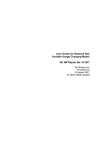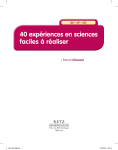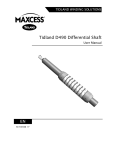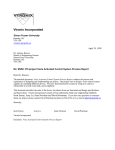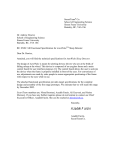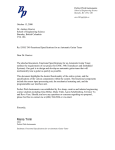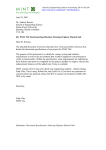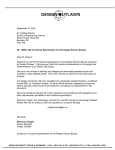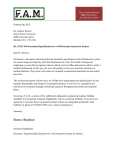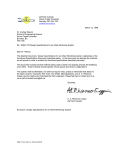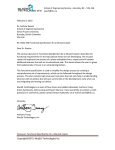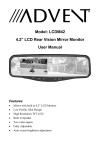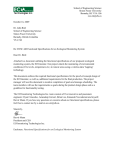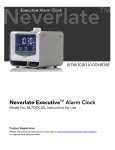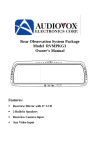Download Automated Windshield Wiper Control System Functional Specification
Transcript
RainWorks Innovations c/o School of Engineering Science Simon Fraser University Burnaby, BC V5A 1S6 Dr. Andrew Rawicz School of Engineering Science Simon Fraser University Burnaby, BC, V5A 1S6 February 16, 1999 Re: ENSC 370 Automated Windshield Wiper Control System Functional Specification Dear Dr. Rawicz The enclosed document, Automated Windshield Wiper Control System Functional Specification, outlines the system requirements for our project. Our project goal is to fully automate windshield wiper control by designing a sensor that will detect the amount of rainfall and control the wipers accordingly. This document describes the required functionality of the overall system and the specifications of various components in the system. The components include the sensor, signal conditioning, and signal processing unit. The members of RainWorks Innovations consist of four 3rd year Engineering Science students in the Electronics option. This four-member team includes Vincent Yen, Roger Stock, Dennis Lee and Kevin Kan. Should any questions arise, please contact Roger Stock at 945-5078 or by e-mail: [email protected]. Sincerely, Vincent Yen, Roger Stock, Dennis Lee and Kevin Kan Encl: Automated Windshield Wiper Control Functional Specifications Automated Windshield Wiper Control System Functional Specification Submitted by: RainWorks Innovations: Vincent Yen, Roger Stock, Dennis Lee and Kevin Kan Contact: Roger Stock [email protected] Submitted to: Andrew Rawicz Steve Whitmore School of Engineering Science Simon Fraser University February 16, 1999 Date: Page ii Automated Windshield Wiper Control System Functional Specifications ______________________________________________________________________ Executive Summary RainWorks Innovations is a group focused on providing solutions for rain oriented automotive products. The current project of RainWorks Innovations involves the automation of windshield wipers for automobiles. The project aim is to develop an automated windshield wiper control system that will activate upon sensing rain and vary the wiper speed accordingly. With the automatic wiper system implementation, there will no longer be any need for user input. However, the user still has the option of a manual override. Currently, RainWorks Innovations intends to custom design a rain sensor for this project. A microcontroller will be implemented into the automatic wiper system to enhance versatility and robustness. The controller involved will be relatively inexpensive and lowpowered. With the parts in mind, the overall system is predicted to be extremely cheap and present an attractive option for car manufacturers or as a car kit for modification enthusiasts. A fully functional prototype will be installed into a Toyota Tercel by April. 5 1999. Page ii Automated Windshield Wiper Control System Functional Specifications ______________________________________________________________________ Table of Contents Executive Summary......................................................................................................... ii Table of Contents ............................................................................................................ ii List of Figures ................................................................................................................. 3 List of Tables .................................................................................................................. 3 Glossary .......................................................................................................................... 4 Introduction .................................................................................................................... 5 Features .......................................................................................................................... 6 System Overview ............................................................................................................ 7 System Flow Chart .......................................................................................................... 8 Sensor ............................................................................................................................. 9 Sensor Input.................................................................................................................... 9 Sensor Output and Signal Conditioning ........................................................................... 9 Signal Processing .......................................................................................................... 10 System Response Time.................................................................................................. 11 User Interface................................................................................................................ 11 Physical Requirements ................................................................................................... 12 Environmental Requirements ......................................................................................... 12 Electrical Requirements ................................................................................................. 13 Safety Considerations .................................................................................................... 13 Compatibility with Other Systems.................................................................................. 14 Known system limitations .............................................................................................. 14 User Training ................................................................................................................ 14 Documentation.............................................................................................................. 14 Test methods................................................................................................................. 15 Conclusion .................................................................................................................... 15 Page ii Automated Windshield Wiper Control System Functional Specifications ______________________________________________________________________ List of Figures Figure 1: AWWCS General Overview ............................................................................. 7 Figure 2: AWWCS Internal Overview ............................................................................. 7 Figure 3: AWWCS System Flow Chart............................................................................ 8 Figure 4: Functional block of sensor ................................................................................ 9 Figure 5: Functional block of controller ......................................................................... 10 List of Tables Table 1: Maximum Sensor Physical Requirements ........................................................ 12 Table 2 : Maximum Controller Box Physical Requirements........................................... 12 Table 3 : Sensor Environmental Requirements .............................................................. 13 Table 4 : Controller Box Environmental Requirements ................................................. 13 Table 5 : Sensor and Controller Box Electrical Requirements ....................................... 13 Page 3 Automated Windshield Wiper Control System Functional Specifications ______________________________________________________________________ Glossary A AWWCS – Automated Windshield Wiper Control System J JIT wiping – Just In Time wiping; wiping of windshield before rain accumulation distracts driver view N Native – Pertaining to the original parameters or controls of the automobile R Response time – time between determined sensor activation and actuation of wiper Page 4 Automated Windshield Wiper Control System Functional Specifications ______________________________________________________________________ Introduction Automobile windshield wiper systems on the current market are completely dependent on user input. Existing windshield wiper systems require user control for different rain conditions, as well as system activation and deactivation. Given various rain conditions that might occur within a short period of time, windshield wiper control may pose a cumbersome task for the driver as well as a dangerous distraction. An inexpensive automated windshield wiper control system, which activates, deactivates and varies the wiper rate depending on rain conditions presents an viable alternative to existing wiper control systems. In addition, the utilization of non-intrusive sensors, inexpensive and customizable microcontrollers and easy installation procedures will make this product an attractive option for car manufacturers or as a car kit for modification enthusiasts. Currently this product is only available in luxury and prototype vehicles, making our inexpensive car kit an accessible alternative for the general public. This document outlines the functional specifications for this concept. Page 5 Automated Windshield Wiper Control System Functional Specifications ______________________________________________________________________ Features The AWWCS shall: • Measure the amount of rainfall and actuate the windshield wipers accordingly • Include manual and automatic wiper mode: - In manual mode windshield wiper control will be overridden by the cars’native control - In automatic mode the wipers will be controlled by the AWWCS, where wipers exhibit JIT wiping • Provide system status LEDs indicating error conditions, and manual/auto mode • Provide sensitivity control over wiper actuation rate • Utilize the car battery as its power source Page 6 Automated Windshield Wiper Control System Functional Specifications ______________________________________________________________________ System Overview The objective of the system is to measure rainfall and actuate the wiper system accordingly. Figure 1 depicts AWWCS relative to the entire wiper control of the car. Given the rain input, the system will process it and then actuate the wipers, thus reducing the amount rain on the windshield. User Remaing Rain AWWCS Rain Acutation Figure 1: AWWCS General Overview Figure 2 gives a closer look of the system block. It shows the sensor and control components, as well as the user input. Manual Override Sensitivity control Rain Remaing Rain on Windshield Sensor Controller Acutation Figure 2: AWWCS Internal Overview The system controls the actuation of the windshield wipers, either through the manual override of the driver or by sensor/controller system. The system senses the amount of rainfall and wipes after accumulation on the windshield passes the threshold. This causes a wipe. Water that remains on the windshield contributes to the feedback loop. Page 7 Automated Windshield Wiper Control System Functional Specifications ______________________________________________________________________ System Flow Chart Figure 3 contains the projected flow of the AWWCS. The system will activate upon car ignition and start a detection loop for rain on the windshield. The sensor portion of the system will continuously check for the presence of rain and send the result to the controller when rain is detected. Based on the data from the sensor, the controller will decide whether or not to wipe. Car Ignition System Activation No Detect Rain on Windshield? Yes Sensor Sensor send conditioned signal to controller Controller process signal Controller Enough rain for wipe? Yes Actuate wiper Figure 3: AWWCS System Flow Chart Page 8 Automated Windshield Wiper Control System Functional Specifications ______________________________________________________________________ Sensor The automated windshield wiper control system requires very specific parameters for data collection. No such sensors with these parameters are currently available on the market, therefore one must be custom designed to fit the specifications listed below. Sensor Rain Sensor Pad Signal Conditioning Signal output as function of Rain coverage Figure 4: Functional block of sensor Sensor Input The AWWCS needs the following data from the sensor to make a meaningful interpretation of the external environment. • The sensor will detect rain fall as input • The sensor will detect raindrops with a minimum size of at least 5mm2 • Other forms of precipitation (snow, hail, etc… ) will not be detected Sensor Output and Signal Conditioning These conditions must be met: • The sensor will output signals that can be deciphered by the controller as percentage of sensor area covered by rain • Sensor output should be within 20% of actual data • The response time of the sensor must be under 10ms – that is, within 10ms of rain falling on the sensor pad, the output should change accordingly Page 9 Automated Windshield Wiper Control System Functional Specifications ______________________________________________________________________ Signal Processing The signal from the sensor will be processed by the controller as shown in Figure 5. The controller analyzes the sensor data and makes an appropriate decision on wiper actuation. User Input over sensitivity Actuation Signal Input from Sensor Controller Figure 5: Functional block of controller The following points must be taken into consideration for signal processing: • The signal processing will be performed by a microcontroller • The controller shall operate from a 10 -12 V power source, or normal car battery operating range • The controller must be able to interpret the sensor input and extract the percentage coverage of rainfall • The controller will output the actuation signal when the rain fall coverage exceeds the default specified threshold of 10 percent • The controller must be able to interface to the wiper actuation system and send a signal to wipe • The response time of the controller must be under 1s – that is the controller must respond within 1s of signal from rain sensor with actuation decision • The controller must activate and deactivate upon car ignition and turnoff • The controller must be able allow user programmability in setting the threshold • The controller must detect sensor errors and self diagnose errors Page 10 Automated Windshield Wiper Control System Functional Specifications ______________________________________________________________________ System Response Time The AWWCS must respond before rain accumulation on the windshield distracts the driver. In addition, the system must account for outlying conditions that may affect system response. The response parameters of the system are outlined. • The system must respond with JIT wiping before rain accumulation on windshield significant affects driver view • Upon initial activation, the system must respond to the fluctuating rain patterns by varying the wiper rate so as to ensure that windshield view is not significant affected at all times • The system must vary wiper rate slowly, to avoid random rain patterns disrupting wiper rate User Interface The objective of the AWCCS is to reduce user interaction, therefore the user interface for the system should facilitate ease of use. This interface should be kept to a minimum number of controls, so that for basic operation the driver need only flip a switch to turn the system on or off. Other considerations in designing the interface are listed below: • • • • sensitivity knob for sensor sensitivity range LEDs to show AWCCS on and error state should not be big and intrusive should obey natural mapping, e.g. should be in close proximity to the car’s native wiper control • should be in visible location Page 11 Automated Windshield Wiper Control System Functional Specifications ______________________________________________________________________ Physical Requirements The system should be as non-intrusive as possible. The sensor placement must be on the windshield, and as such sensor size should be kept to a minimum to avoid obstructing the driver’s vision. In addition, sensor should be clear if placed as part of the windshield. The controller box will be placed within the car and therefore dimensions should be minimized. The maximum dimensions for the sensor and the controller box (which will be kept inside the car) are listed below. Length Height Thickness Weight Table 1: Maximum Sensor Physical Requirements 200 mm 100 mm 2.5 mm 0.5 kg Length Height Thickness Weight Table 2 : Maximum Controller Box Physical Requirements 200 mm 100 mm 50 mm 0.5 kg Environmental Requirements Both the controller box and the sensor must endure a range of unfavorable conditions. The sensor will be subject to abuse from exterior exposure and must be durable enough to withstand constant wiping action. The controller box must withstand the heat caused by placement under the car’s hood and also be static proof. For the portion of the sensor that is in contact with windshield, special considerations should be made to account for expansion and contraction due to temperature fluctuations. In addition, bonding substances should be carefully selected to avoid warping of the sensor. The following tables are the environmental conditions that our system must meet or exceed. Page 12 Automated Windshield Wiper Control System Functional Specifications ______________________________________________________________________ Table 3 : Sensor Environmental Requirements Operating temperature range 0C – 40C Table 4 : Controller Box Environmental Requirements Operating temperature range -40C – 120C Vibrations ±2 g Corrosive resistant container Yes Electrical Requirements The AWWCS will utilize the car battery as its power source. Therefore, the AWWCS must be able to operate under a range of car battery states. In addition, care must be taken to avoid excess power consumption and draining the batteries, therefore the system will not be activated when the car is turned off. During normal operation without rain, the system should operate in a power saving standby mode. Table 5 : Sensor and Controller Box Electrical Requirements Operating voltage range Maximum operating current range during standby mode Maximum operating current range during active mode DC 10 – 12V 20mA 100mA Safety Considerations The controller box will be placed under the car hood enduring high temperatures; therefore, care must be taken to avoid the usage of flammable materials. In addition, static isolated boxes will be used to protect the microcontroller. Fuses will be used to prevent current damages to the controller. The sensor must not pose a safety hazard to the user or anyone else. The sensor must not give harmful discharge; if any electrical network is used in the sensor, proper care must be taken to ensure that electrical shock, fatal or otherwise must not be given. If an optical solution is used to detect rain, necessary precautions must be taken to ensure that the emitter (laser or otherwise) not pose a threat to the human body. Page 13 Automated Windshield Wiper Control System Functional Specifications ______________________________________________________________________ Compatibility with Other Systems The AWCCS system prototype will be placed in a 1987 Toyota Tercel, therefore the system must be fully installable to this car. Upon completion of the prototype, the system will be modified toward general automobile installation as a car kit. However, this project task is outside the scope of the project work for Ensc 370 and current emphasis is to create the system prototype. Known system limitations The AWCCS system is limited by the following: • The ability to detect snow/ice/dust/non-liquid objects. • The ability to detect precipitation off or beyond the sensor. • The use of the automobiles’system for wiper actuation. Limiting parameters would include maximum native wiper rates, etc. User Training System use is limited to only a few input controls so training is minimal. Full details of system operation will be provided in the user manual. Documentation The objective of the AWCCS is to reduce user interaction so very little documentation is required for user operation. However, the user will need to be informed of the following points in the user manual: • • • • Error conditions/Exception cases LED information states Sensitivity adjustment parameters Manual override control Once the product is past the prototype stage, the add-on kit form of the AWCCS for any car will be developed, requiring do-it-yourself installation guidelines. This task is outside the scope of the project work for ENSC 370. Page 14 Automated Windshield Wiper Control System Functional Specifications ______________________________________________________________________ Test methods The functionality of the AWWCS will be tested manually and in a natural environment. Manual testing will consist of applying water to the windshield to simulate the various conditions of rainfall. When weather permits, the system will be tested in its intended environment. During testing to verify all given functional specifications, the following variables will be considered: • Driving parameters: - Car velocity - Effects of incline - Driving events e.g. turning, bumps, urban/rural diving, etc • Temperature • Various rainfall conditions - Raindrop size - Rainfall rate and pattern Conclusion The functional aspects of our Automatic Windshield Wiper Control System have been outlined in this document. The system implementation will follow these specifications. In doing so, RainWorks Innovations hopes to fulfill all company objectives, including successfully completing the ENSC 370 project course and continuing product development for commercial application. Page 15




















